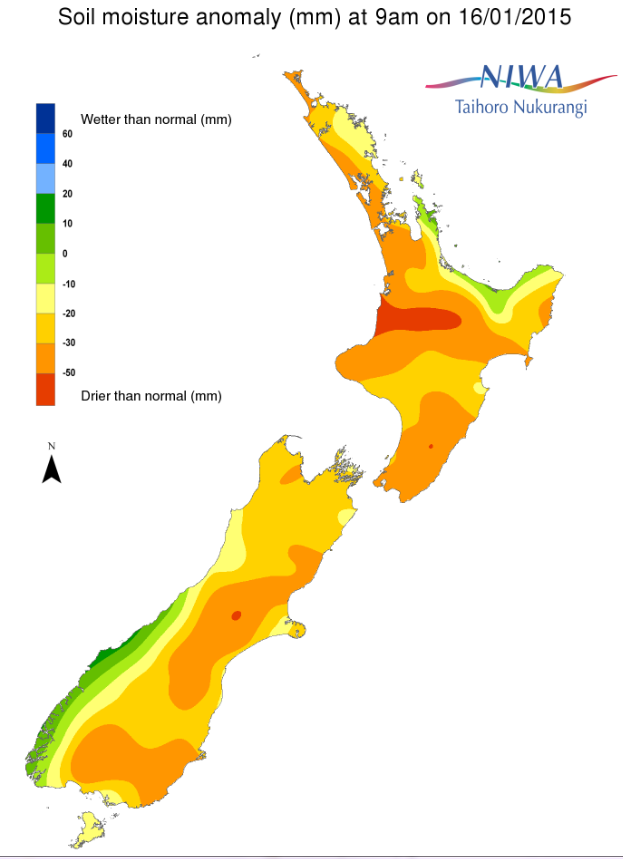NIWA's Hotspot Watch 20/1/15
Friday, 16 January 2015
NIWA's Hotspot Watch
Weekly update to help media assess likelihood of extremely dry weather preceding a drought. Regions experiencing severely to extremely drier than normal soils conditions are deemed “hotspots”.
Facts: Soil Moisture
For the North Island, soil moisture levels have continued to decrease and drier to severely drier than normal soils for this time of year now dominate much the island. In particular, soil moisture levels in the Wairarapa region and parts of the Hawke’s Bay are extremely drier than normal. Soils in Waikato, parts of Auckland and the upper Far North are also much drier to severely drier than normal for this time of year
For the South Island, the continued lack of significant rainfall has meant that severely to extremely drier than normal soil moisture levels for this time of year have continued in the eastern portion of the island. Canterbury and Otago are currently the worst affected regions.
Week-to-Week Comparison
When compared to this time last week it is apparent that widespread dryness now covers much of New Zealand. They key hotspot regions of Canterbury and Otago remain extremely drier than normal with scattered showers in the region over the past week bringing little relief. The upper West Coast, Tasman, Nelson and Marlborough regions have also seen the expansion of drier than normal soils. Similarly drier than normal soils in the North Island have expanded in coverage when compared to last week. Thunderstorms in eastern Waikato last Friday brought some short term reprieve to the area, however, soils in the greater Waikato region remain extremely drier to severely drier than normal.
Commentary
For the North Island, when considering the current soil moisture anomalies for this time of year, the Wairarapa and southern Hawkes Bay region is a hotspot as soils in this region have been severely to extremely drier than normal for several weeks. Farther north, much of the Waikato is a hotspot area, as soil moisture continues to decrease. Increasingly dry conditions in Auckland have meant that hotspots are now developing in parts of the region. The Far North will need to be monitored for possible hotspot development over the coming days and weeks as soils there have trended drier over the past 1-2 weeks.
For the South Island, hotspots exist throughout Canterbury and Otago as the coverage and size of the hotspot area has grown. Northern parts of the South Island have also continued to dry out over the past 1-2 weeks and will need to be monitored for possible hotspot development.
For hotspot regions, sustained rainfall over an extended period of time is needed to return conditions back to normal. Additionally, if current conditions persist or worsen, then drought conditions may be imminent.
Background:
Hotspot Watch a weekly advisory service for New Zealand media. It provides soil moisture and precipitation measurements around the country to help assess whether extremely dry conditions are imminent.
Soil moisture deficit: the amount of water needed to bring the soil moisture content back to field capacity, which is the maximum amount of water the soil can hold.
Soil moisture anomaly: the difference between the historical normal soil moisture deficit (or surplus) for a given time of year and actual soil moisture deficits.
Definitions: “Extremely” and “severely” dry soils are based on a combination of the current soil moisture status and the difference from normal soil moisture (see soil moisture maps at https://www.niwa.co.nz/climate/nz-drought-monitor/droughtindicatormaps)
Pictured below: Soil Moisture Anomaly Maps, relative to this time of year. On the left are values this time last week. On the right are the most recent values.Pictured below: Soil Moisture Anomaly Maps, relative to this time of year. On the left are values this time last week. On the right are the most recent values.




 Commerce Commission: Commission Concludes Auckland Airport Over-charging By $190 Million
Commerce Commission: Commission Concludes Auckland Airport Over-charging By $190 Million The Future Is Rail: Ferry Decision - Common Sense Prevails
The Future Is Rail: Ferry Decision - Common Sense Prevails Aotearoa Food Rescue Alliance: Grocery Market Reform Must Include Mandatory Food Rescue Partnerships
Aotearoa Food Rescue Alliance: Grocery Market Reform Must Include Mandatory Food Rescue Partnerships Hugh Grant: Zero Trust Security - A Buzzword Or The Ultimate Protection?
Hugh Grant: Zero Trust Security - A Buzzword Or The Ultimate Protection? Bill Bennett: Comcom revisits fibre rules as competition intensifies
Bill Bennett: Comcom revisits fibre rules as competition intensifies Bill Bennett: Download Weekly Extra - InternetNZ disrupted
Bill Bennett: Download Weekly Extra - InternetNZ disrupted



